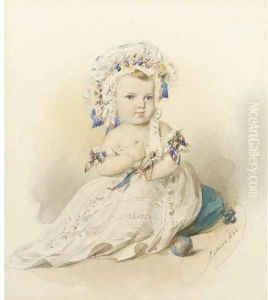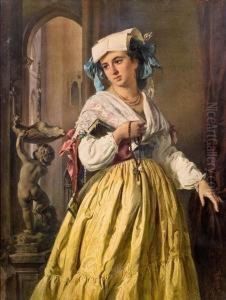Franz Pitner Paintings
Franz Pitner was an Austrian artist, best known for his contributions to ceramics and his role in the development of the Viennese ceramic industry in the late 19th and early 20th centuries. Born on February 22, 1846, in the town of Znaim, Moravia, which at the time was part of the Austro-Hungarian Empire and is now in the Czech Republic, Pitner demonstrated an early aptitude for the arts, particularly in the medium of ceramics.
After completing his initial education, Pitner went on to hone his skills at the School of Applied Arts in Vienna, a hub for the burgeoning arts and crafts movement in Austria. His talent was recognized by his instructors, and he quickly made a name for himself as a skilled ceramist and craftsman. In 1874, he took a significant step in his career by joining the Imperial and Royal Porcelain Factory in Vienna, known as the Augarten Porcelain Manufactory.
Pitner's work at the Augarten Porcelain Manufactory was marked by his dedication to quality and innovation. He was instrumental in developing new techniques and designs, which helped propel the Viennese ceramic industry to new heights. His legacy includes a variety of decorative objects and practical wares that combined traditional craftsmanship with the aesthetic sensibilities of the time, reflecting the influence of Art Nouveau and the Secessionist movement.
Beyond his individual contributions, Pitner was also a respected educator who taught at the School of Applied Arts in Vienna, where he had once been a student. His teaching and mentorship helped shape the next generation of Austrian ceramists and artists. Pitner's influence extended beyond the classroom, as he participated in various exhibitions and was involved in the artistic community in Vienna.
Franz Pitner's career was marked by a commitment to elevating the status of ceramics as a fine art. His work received numerous accolades, and he was celebrated for his ability to blend artistic vision with technical mastery. Pitner passed away on October 17, 1921, in Vienna. Today, his legacy lives on through his contributions to the field of ceramics and his impact on the Viennese artistic community.

